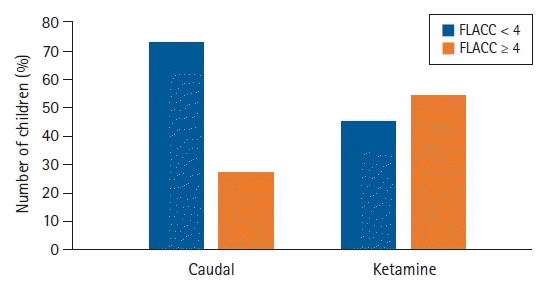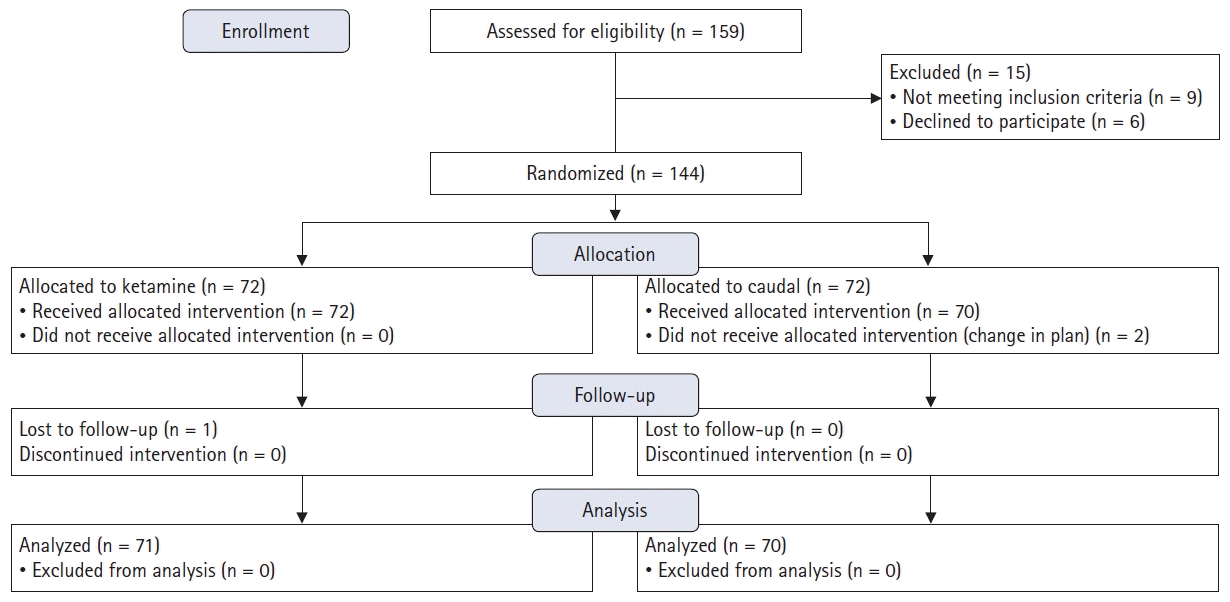1. de Beer DA, Thomas ML. Caudal additives in children-solutions or problems? Br J Anaesth. 2003; 90:487–98.

2. Wiegele M, Marhofer P, Lönnqvist PA. Caudal epidural blocks in paediatric patients: a review and practical considerations. Br J Anaesth. 2019; 122:509–17.

3. Suresh S, Lonnqvist PA. Regional anesthesia in children. In: Miller’s Anaesthesia. 9th ed. Gropper MA, Cohen NH, Eriksson LI, Fleisher LA, Leslie K, Winer-Kronish JP, editors. Philadelphia: Elsevier Health Sciences;2019. p. 2368–419.
4. Taicher BM, Routh JC, Eck JB, Ross SS, Wiener JS, Ross AK. The association between caudal anesthesia and increased risk of postoperative surgical complications in boys undergoing hypospadias repair. Paediatr Anaesth. 2017; 27:688–94.

5. Amiri HR, Espandar R, Sanatkar M. Comparing caudal and intravenous ketamine for supplementation of analgesia after Salter innominate osteotomy. J Child Orthop. 2012; 6:479–83.

6. Naguib M, Sharif AM, Seraj M, el Gammal M, Dawlatly AA. Ketamine for caudal analgesia in children: comparison with caudal bupivacaine. Br J Anaesth. 1991; 67:559–64.

7. Verghese ST, Hannallah RS. Acute pain management in children. J Pain Res. 2010; 3:105–23.

8. Lee CA. Paediatric emergence delirium: an approach to diagnosis and management in the postanaesthesia care unit. J Perioper Crit Intensive Care Nurs. 2017; 3:140.

9. Merkel SI, Voepel-Lewis T, Shayevitz JR, Malviya S. The FLACC: a behavioral scale for scoring postoperative pain in young children. Pediatr Nurs. 1997; 23:293–7.
10. Dalens B, Hasnaoui A. Caudal anesthesia in pediatric surgery: success rate and adverse effects in 750 consecutive patients. Anesth Analg. 1989; 68:83–9.
11. Hirota K, Lambert DG. Ketamine: its mechanism(s) of action and unusual clinical uses. Br J Anaesth. 1996; 77:441–4.

12. Sheehy KA, Lippold C, Rice AL, Nobrega R, Finkel JC, Quezado ZM. Subanesthetic ketamine for pain management in hospitalized children, adolescents, and young adults: a single-center cohort study. J Pain Res. 2017; 10:787–95.

13. Martindale SJ, Dix P, Stoddart PA. Double-blind randomized controlled trial of caudal versus intravenous S(+)-ketamine for supplementation of caudal analgesia in children. Br J Anaesth. 2004; 92:344–7.

14. Dix P, Martindale S, Stoddart PA. Double-blind randomized placebo-controlled trial of the effect of ketamine on postoperative morphine consumption in children following appendicectomy. Paediatr Anaesth. 2003; 13:422–6.

15. Mion G. Ketamine stakes in 2018: right doses, good choices. Eur J Anaesthesiol. 2019; 36:1–3.
16. De Kock M, Loix S, Lavand’homme P. Ketamine and peripheral inflammation. CNS Neurosci Ther. 2013; 19:403–10.

17. Loix S, De Kock M, Henin P. The anti-inflammatory effects of ketamine: state of the art. Acta Anaesthesiol Belg. 2011; 62:47–58.
18. Morris P, Ali K, Merritt M, Pelletier J, Macedo LG. A systematic review of the role of inflammatory biomarkers in acute, subacute and chronic non-specific low back pain. BMC Musculoskelet Disord. 2020; 21:142.

19. Chen MH, Li CT, Lin WC, Hong CJ, Tu PC, Bai YM, et al. Rapid inflammation modulation and antidepressant efficacy of a low-dose ketamine infusion in treatment-resistant depression: a randomized, double-blind control study. Psychiatry Res. 2018; 269:207–11.

20. Kawasaki C, Kawasaki T, Ogata M, Nandate K, Shigematsu A. Ketamine isomers suppress superantigen-induced proinflammatory cytokine production in human whole blood. Can J Anaesth. 2001; 48:819–23.

21. Watt DG, Horgan PG, McMillan DC. Routine clinical markers of the magnitude of the systemic inflammatory response after elective operation: a systematic review. Surgery. 2015; 157:362–80.

22. Bantis A, Tsakaldimis G, Zissimopoulos A, Giannakopoulos S, Kalaitzis C, Pitiakoudis M, et al. Can tumor necrosis factor- α and interleukin-6 be used as prognostic markers of infection following ureteroscopic lithotripsy? ISRN Urol. 2014; 2014:457063.
23. Lee EN, Lee JH. The effects of low-dose ketamine on acute pain in an emergency setting: a systematic review and meta-analysis. PLoS One. 2016; 11:e0165461.

24. Sinha A, Sood J. Caudal block and emergence delirium in pediatric patients: is it analgesia or sedation? Saudi J Anaesth. 2012; 6:403–7.

25. Nafiu OO, Kolawole IK, Salam RA, Elegbe EO. Comparison of caudal ketamine with or without bupivacaine in pediatric subumbilical surgery. J Natl Med Assoc. 2007; 99:670–3.






 PDF
PDF Citation
Citation Print
Print




 XML Download
XML Download